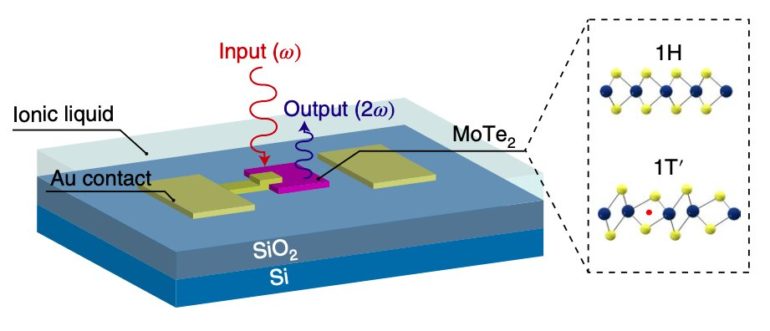Nonlinear optics is a research field that explores how intense light interacts with matter. Typically, the optical response of materials is linearly associated with the amplitude of the electric field applied to them. At particularly high amplitudes, however, the optical properties of materials can change more rapidly, resulting in nonlinear optical responses.
Nonlinear optical properties are crucial for enabling many known light-matter interactions, such as harmonic generation, self-focusing, and spontaneous parametric down conversion. However, to develop new photonic technologies, such as advanced laser spectroscopy tools, on-demand quantum light sources and photonic circuits, engineers should be able to control dynamically control the nonlinear optical properties of crystals.
The electrical modulation of a nonlinear optical property known as second-order nonlinearity (i.e., where optical fields interact with a nonlinear medium and produce optical fields with a doubled frequency), could be particularly crucial for the development of on-chip optical technologies, such as compact lasers or photonic neural networks.
Directly modulating the second-order nonlinearity or optical susceptibility of materials has so far proved to be challenging. This is partly because to modulate this property, it is necessary to switch the symmetry of a crystal’s atomic structure, which might require high temperatures or irreversible chemical interventions that might be difficult to execute for on-chip devices.
Many researchers have thus simply elicited second-harmonic effects by applying an electric field to materials, which indirectly produce a second-order optical response without changing the atomic structure of their crystals. However, these effects are typically weak and cannot be modulated without large electrical voltages.
Researchers at University of California, Berkeley and the University of Hong Kong have recently realized the direct electrical modulation of second-order optical susceptibility in monolayer molybdenum ditelluride (MoTe2), a compound that can be crystallized in very thin two-dimensional (2D) sheets and can be thinned down to monolayers. Their paper, published in Nature Electronics, could have important implications for the future development of photonic technologies.
To modulate second-order optical susceptibility, the team electrically modified the crystal structure of MoTe2 between the material’s non-centrosymmetric and centrosymmetric phases. In other words, they switched the inversion symmetry of the MoTe2 crystals, which in turn allowed them to directly tune the intensity of second-harmonic generation effects.
“We show that electrical switching of the crystal structure of monolayer molybdenum ditelluride can be used to directly modulate the second-order optical susceptibility,” the researchers wrote in their paper. “This approach leads to modulation of the second-harmonic generation with an on/off ratio of 1,000 and modulation strength of 30,000% per volt, as well as broadband operation of 300nm.
Remarkably, the team found that the modulation could be carried out at room temperature, exhibiting the exact same on/off rations after 30 modulation cycles. Interestingly, however, when trying to achieve the same modulation using bilayer MoTe2, as opposed to monolayer MoTe2, they observed opposite modulation trends, due to the broken inversion symmetry in the material.
In the future, the modulation strategy presented in their paper could enable the fabrication of new, compact photonic devices and circuits. Its large-scale implementation could also be accelerated by recent advances in the realization of spatially well-defined high-dielectric gates and macroscopic monolayers based on 2D van der Waals crystals.
Natural three-dimensional nonlinear photonic crystal
More information:
Ying Wang et al, Direct electrical modulation of second-order optical susceptibility via phase transitions, Nature Electronics (2021). DOI: 10.1038/s41928-021-00655-0
2021 Science X Network
Citation:
A strategy to directly modulate the second-order optical susceptibility of monolayer molybdenum ditelluride (2021, October 25)
retrieved 25 October 2021
from https://techxplore.com/news/2021-10-strategy-modulate-second-order-optical-susceptibility.html
This document is subject to copyright. Apart from any fair dealing for the purpose of private study or research, no
part may be reproduced without the written permission. The content is provided for information purposes only.
